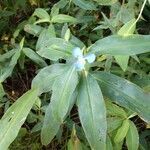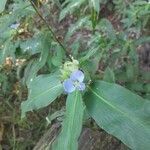Rhizomatous perennial; stem stout, erect or nearly so, to 12 dm, often widely branched; lf-blades lanceolate, long-acuminate, scabrous above, glabrous or finely hairy beneath, the main ones 10–20 × 2.5–5 cm; sheaths pilose-ciliate with red-brown hairs 2–5 mm, not prolonged into distinct auricles; spathes usually clustered toward the summit, sessile or short-peduncled, 2–3(–3.5) cm, nearly as wide when folded, the nerves connected by numerous cross-veins, the margins connate in the lower third; lower pet blue, scarcely reduced; fr 3-locular, the lower locules each 2-seeded, the upper one 1-seeded; 2n=60. Moist or wet woods; N.J. to Fla., w. to Ill., Kans., Okla., and Tex. (C. hirtella)
A herb.





